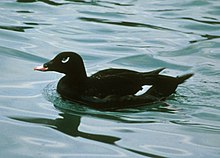Scoter
| Scoters | |
|---|---|

| |
| Adult male white-winged scoter (Melanitta deglandi) | |
| Scientific classification | |
| Domain: | Eukaryota |
| Kingdom: | Animalia |
| Phylum: | Chordata |
| Class: | Aves |
| Order: | Anseriformes |
| Family: | Anatidae |
| Subfamily: | Merginae |
| Genus: | Melanitta F. Boie, 1822 |
| Type species | |
| Anas fusca (velvet scoter) Linnaeus, 1758
| |
| Species | |
|
See text | |
| Synonyms | |
|
Oidemia | |
The scoters are stocky seaducks in the genus Melanitta. The drakes are mostly black and have swollen bills, the females are brown. They breed in the far north of Europe, Asia, and North America, and winter farther south in temperate zones of those continents. They form large flocks on suitable coastal waters. These are tightly packed, and the birds tend to take off together. Their lined nests are built on the ground close to the sea, lakes or rivers, in woodland or tundra. These species dive for crustaceans and molluscs.
Taxonomy
[edit]The genus Melanitta was introduced by the German zoologist Friedrich Boie in 1822.[1] The type species was designated in 1838 as the velvet scoter by Thomas Campbell Eyton.[2] The genus name combines the Ancient Greek melas meaning "black" and netta meaning "duck".[3]
The genus contains six species:[4]
| Image | Scientific name | Common name | Distribution |
|---|---|---|---|
 |
Melanitta americana | black or American scoter | north of North America in Labrador and Newfoundland to the southeast Hudson Bay |
 |
Melanitta nigra | common scoter | north of Europe and Asia east to the Olenyok River |
 |
Melanitta fusca | velvet scoter | eastern Turkey, Europe as far south as Great Britain, and on the Black and Caspian Sea |
 |
Melanitta deglandi | white-winged scoter | North America |
 |
Melanitta stejnegeri | Stejneger's scoter | far north of Asia east of the Yenisey Basin |
 |
Melanitta perspicillata | surf scoter | North America, mostly in Northern Canada and Alaska |
The presumed fossil "scoter" Melanitta ceruttii, which lived in California during the Late Pliocene, is now placed in the genus Histrionicus.
References
[edit]- ^ Boie, Friedrich (1822). Tagebuch gehalten auf einer Reise durch Norwegen im Jahre 1817 (in German). Schleswig: Königl Taubstummen - Institut. pp. 308, 351.
- ^ Eyton, Thomas Campbell (1838). A Monograph on the Anatidae, or Duck Tribe. London: Longman, Orme, Brown, Green, & Longman. p. 52.
- ^ Jobling, James A (2010). The Helm Dictionary of Scientific Bird Names. London: Christopher Helm. p. 246. ISBN 978-1-4081-2501-4.
- ^ Gill, Frank; Donsker, David; Rasmussen, Pamela, eds. (July 2021). "Screamers, ducks, geese & swans". IOC World Bird List Version 11.2. International Ornithologists' Union. Retrieved 16 October 2021.
Text is available under the CC BY-SA 4.0 license; additional terms may apply.
Images, videos and audio are available under their respective licenses.


